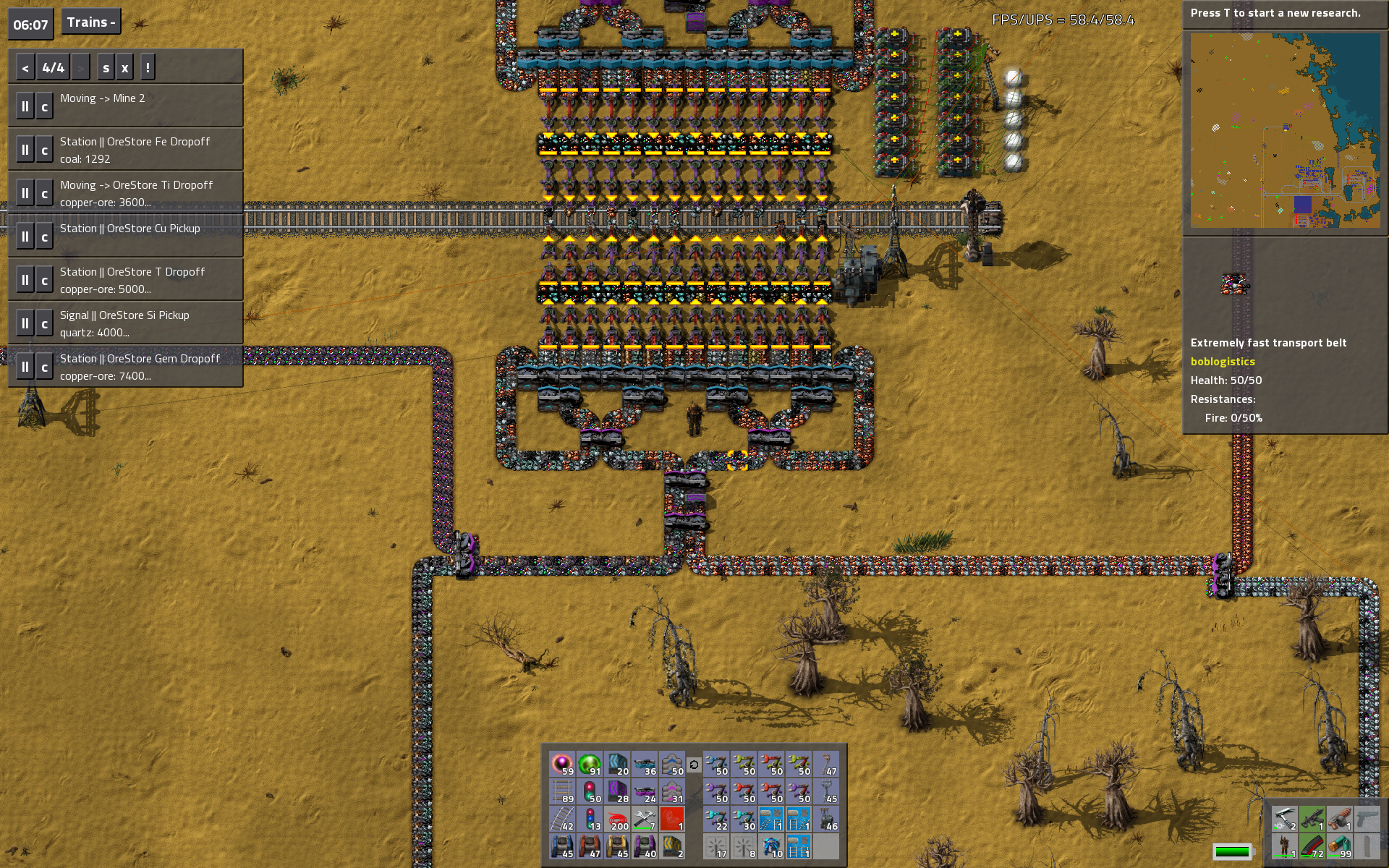I finally got around to getting screenshots of the Bob's Mod factory I've been working on. There's about 160 hours on this map so far.
I'm basically using rail as a widely distributed, high-capacity main bus, with smaller production units that make products that have similar inputs. The products then get put back onto trains, either to be picked up as material for another sub-factory, or taken to a central supply depot that I can pick stuff up from.
And yes, I was OCD enough to pave under every single bit of permanent wall and rail on the map.

(The forum still chops off the right side of all the images, so you have to right-click and view the image to see the whole thing

)
Overview map. Train stop labels should be enough to tell you what's what. The mess in the middle is the smelting area.
Zoomed out map, with perimeter wall and power/radar grid. The wall has a service rail that drops off spare parts for the construction bots (which cover the entire wall). Completely maintenance-free.
Batteries, solar panels, and accumulators. If you're making all of top-tier items that use the lithium batteries, the copper/cobalt output ratio of the cobalt oxide-producing copper smelt is very, very close to exactly what you need, so I just produce most of the copper on-site instead of bringing it in. The combinator logic imports extra copper if the cobalt buffer is full and copper is empty, and exports copper when copper is full and cobalt is empty (preventing the copper smelting from being clogged up). Excess H2 is taken away and made into solid fuel. The lithium-chain production in the NW corner is designed to be easily extendable to the north.
All tiers of belts (incl. splitters and underground) and assemblers, and my most-commonly-used inserter types.
Chemical plant. The combinator logic sends excess H2 to be made into solid fuel to make sure O2 and Cl2 don't go dry, and will void O2 if the H2 supply gets low and O2 is full. The only annoying part is having to come by occasionally and take a shotgun to the NaOH overflow chests.
Circuit production (with a temporary module research facility bolted to the side). Nothing particularly special. The export train stop is extremely busy, hence the convoluted waiting area for up to three additional trains.
Gem processing. Nothing particularly interesting here, really.
Military production. Only making what I actually use. The central supply depot is just to the NW. The output chests are in its logistics network, so I don't have to export by rail.
Module production. Green 7s and Speed 8s that I actually use extensively, and God 5s that I don't use, but make continuously and stockpile just for the heck of it. Plenty of room for expansion. Must have more God 5s.
Oil refining and cracking. The fraction levels are managed automatically. The heavy->light pumps are on any time there's more heavy in storage than light. The light->PG pumps are on any time there's more light than PG. If PG is getting full and heavy is low, the petroleum processing area starts making solid fuel out of PG.
Production of oil-derived products. The combinators control production of solid fuel, which is currently primarily used to run the trains. It will prefer light oil for solid fuel production to maintain solid fuel inventory, unless there's over 2x as much PG as light oil in storage. If PG is full and heavy low, it will make solid fuel from PG regardless of the current solid fuel inventory level.
Robotics facility. Since I had to make engines, anyway, I stuck trains in there, too...
Silicon processing. Designed to be expandable to the S and E if necessary. This station ended up being a lot busier than I thought it would be, which is why the waiting area is a bit funny-looking to cram in an extra train.
Overview of the central smelting area. Ore comes in at the south end, metal goes out at the top. Next time, I'm reserving less space for copper and iron, and much more for tin/lead/solder plate!
The export platforms for the smelting area - by far the busiest station. Trains move left to right, and can pick up any combination of metals by stopping at the three stations. The stacked std in/long out+log in/std out express inserters mean that a train doesn't usually need to spend more than 20-25 seconds to get all the way through, even stopping at all three stations. Should be able to handle 15-20 trains/minute.
Other stuff. These two make miners, pumpjacks, electric poles, walls, logistics chests, rail, etc. Basically most of the infrastructure.
My central supply depot. The top two platforms are for the trains that go around the map collecting finished products. The center is for my passenger train, and the bottom is the one where the wall train picks up construction bots, walls, lasers, and repair packs for the perimeter wall.
Iron and copper ore dumps. There's one for each type of ore, and fully populated with logistics chests, they can hold upwards of 30 million ore each. Trains from the mines carry a mixed cargo around to each of the dumps which takes its ore type off the train. Another set of trains picks up ore to take to the smelting area (regulated by the circuit network, so as not to clog up the shared unloading chests).
The rocket launch complex. Everything is produced on-site. I didn't bother unloading the trains - the assemblers are set up so that they can just use the train directly to get materials. The schedules and cargo filters are set up so that it takes off for a refill just as it empties out. The train that brings in PG and light oil for solid fuel has its own loading stop, and which type gets loaded depends on current fraction inventory levels.




















